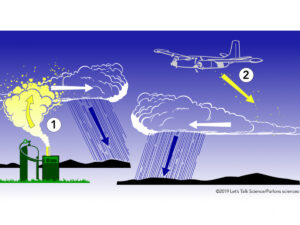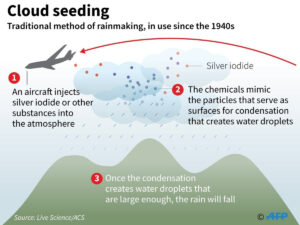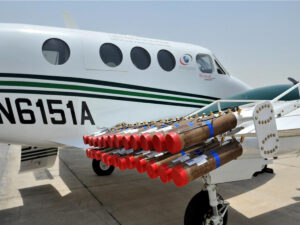
What is cloud seeding?
- March 7, 2022
- 0
Cloud seeding is a type of weather modification, which disperses certain chemical substances into the air, to modify the amount or type of precipitation that falls from existing clouds.
How does it work?
Cloud seeding chemicals include silver iodide, potassium iodide and dry ice (solid carbon dioxide). These chemicals are released into the air using two methods:
– Aircrafts, which drop the particles from above by flying through the inflow of a cloud,
– Dispersion devices (such as cannons) located on the ground, which shoot large quantities of the chemical substance that will be carried high by air currents after release.

1-Cloud seeding by dispersion devices; 2-Cloud seeding by aircrafts
The crystalline silver iodide particles have a structure similar to ice. Once inside the cloud, “Ce qui se ressemble s’assemble”; water droplets begin to cluster around it and freeze as they gather together. These frozen clusters eventually grow too heavy and fall from the clouds as snow.

Silver iodide can also be used to reduce the size of hail naturally produced; it was a project funded by insurance companies in Canadian Alberta, in an effort to minimize property damage caused by hailstorms every year. The process called “hail reduction or suppression” aims to create more ice crystals at warmer temperatures that compete for the cloud’s liquid water, therefore making smaller hail.
Also, warm areas such as the UAE, which receive less than 100 millimeters of annual rainfall, are turning to cloud seeding in an attempt to increase rain. They fire salt crystals into warm clouds that have an updraft. The latter then sucks up the ice crystals into the cloud, which attract tiny particles of water that collide, becoming heavier and eventually falling as rain. This is called hygroscopic seeding.

What are the pros of cloud seeding?
-Rain creation: Essential in keeping areas fertile and hydrated for farming purposes, where natural rain is not enough.
-Weather regulation: Some weather conditions can be dangerous if not properly managed. Cloud seeding provides control by limiting precipitation which could develop into storms causing mass destruction.
-Reduction of crop/property damage: It can manage the formation of storm clouds.
-Geographically oriented: It can create a micro-climate. For example, airports can use it to create stable weather conditions for their runways.
-Reduction of the impact of droughts: Droughts can be prevented in dry areas by increasing rainfall.
What are the cons of cloud seeding?
-Uses dangerous chemicals: The chemicals produced during cloud seeding are present in the water and soil deposits of the area where it has been practiced. For example, if exposed to high amounts of silver, one can develop permanent skin problems. Also, there has been a rising situation of iodism, which is a type of poisoning caused by iodine. It has severe effects on people such as skin rashes, headaches, and running noses among other symptoms. Not to mention that all these chemicals disrupting natural ecosystems will eventually harm plants and animals.
– It is expensive: Planes are used to get the chemicals into the air and this is a big obstacle in areas where famine and drought are rampant and cannot afford the technology.
-Poses weather problems: Dry areas are not usually well-positioned to handle certain weather conditions, and thus, may become easily flooded and cause more harm to the already struggling environment. Also, there are claims that increasing rain in one area can have the opposite effect on the neighboring areas, and accusations of “stealing rain” have been causing conflicts between those areas.
Conclusion
Cloud seeding is a controversial idea; some countries fund and apply it (like Russia and China), other countries are still skeptical and do not offer government funding for it. These techniques still need a lot of studies and research to assess long term implications that come from cloud seeding. In addition, there is not enough evidence that this process is actually beneficial for increasing or decreasing precipitation. Despite having a good number of positive impacts, it also comes with threats that are not well understood yet which makes it an unreliable solution.
Cover picture: Thomson Reuters foundation news.
Prepared by: Mira Sabbagh











